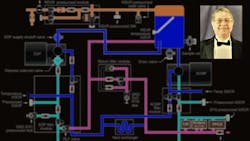With wasted energy through hydraulic systems estimated to cost operators $17 billion a year, the topic of improving hydraulic system efficiency promises to be one of the more important topics at IFPE 2020 in Las Vegas.
Thomas Blansett, CFPAI, CFPS, technical director of the International Fluid Power Society, will present Assessing Your Hydraulic System Efficiency on Fri., March 13 from 11 a.m. to 12:30 p.m. in room S230 of the Las Vegas Convention Center. This session will look at some of the areas where hydraulic energy inefficiencies occur and discuss key items for evaluating an industrial hydraulic system to determine recommendations to improve efficiency and lower the total cost of ownership. Specifics include looking at the sizing of prime movers, selection of fluid, contamination control, type of pump utilized along with its controls, valving, and actuator selection.
Blansett spoke with Hydraulics & Pneumatics about some of the fundamentals around efficiency, and how it works in the age of IoT:
H&P: What are the most overlooked areas in hydraulic system efficiency?
Blansett: In my opinion, one of the biggest issues with designing energy efficient hydraulic systems is the lack of experienced and knowledgeable designers that take into account all of the potential energy losses within a system. Too many designers are using rules of thumb for sizing components rather than optimizing the design for the lowest energy loss and letting initial capital cost determine the solution when total cost of ownership and reliability of the system during its lifecycle should drive the design.
There are modeling software packages that allow a designer to look at different possible solutions and get an estimate of the energy losses per solution to enable choosing the best solution for the application.
Blansett: In a manufacturing facility, production output is the governing factor in many decisions made regarding energy efficiency. Routine maintenance items which help maintain system efficiency are often neglected as being too much of a delay to output especially if requiring a shut-down of a machine or line. Thus, many opportunities to reduce energy consumption are not performed.
Proper training of all personnel to understand how and why to reduce energy consumption can help to overcome this attitude. Incorporating into the design of the system the capability to monitor and regulate operating parameters to minimize energy waste is also an important area that often gets left out of the system design due to the initial capital cost.
H&P: Is there a role for the Industrial Internet of Things in hydraulic system measurement and management?
Blansett: There is absolutely a major role for IoT in hydraulics to provide the measurements necessary to monitor and the controls necessary to regulate the operating characteristics of the hydraulic system. Being able to continuously monitor and analyze performance and adjust as required utilizing IoT will have the potential to significantly reduce energy waste if properly designed and implemented.
IFPE Research Symposium Offers Lunch Courses
The IFPE Research Symposium will serve up lunch and knowledge during the 2020 show in Las Vegas March 10-14. The National Fluid Power Association will showcase the latest fluid power research at universities that have been funded from a new program within the U.S. Department of Energy to improve the energy efficiency of hydraulic systems on off-road vehicles.
The three sessions are:
Individual Electro-Hydraulic Actuators for Off Road Machines Andrea Vacca, Purdue University
Wed., March 11, 11:30 a.m. to 12:30 p.m., Room S231
This project proposes a new technology for electro-hydraulic actuators suitable for off-road construction machines. The main project goal is accomplished by formulating a novel design for a four quadrant electro-hydraulic supply unit, which is coupled to a linear actuator by means of a hydraulic circuit that minimizes the throttling loss. The project takes as reference the case of a compact wheel loader, for which it is expected to achieve an improvement on the energy consumption of the hydraulic system up to 70%, depending on the drive cycle.
Efficient, Compact, and Smooth Variable Propulsion Motor James Van de Ven, University of Minnesota
Thurs., March 12, 11:30 a.m. to 12:30 p.m., Room S231
This work will develop a revolutionary variable displacement hydraulic motor for the propulsion drive of off-highway vehicles. The motor combines unmatched efficiency at all displacements, high displacement density, and low torque ripple. The high efficiency is a result of the mechanism using all rolling element bearings, low piston side-loads, and minimal unswept cylinder volume. The high displacement density is achieved through the radial piston packaging and a multi-lobe cam, creating multiple piston strokes per revolution. This talk will present the model-driven design, optimization, and experimental testing of a prototype motor.
Hybrid Hydraulic-Electric Architecture for Mobile Machines Perry Li, University of Minnesota
Fri., March 13, 11:30 a.m. to 12:30 p.m., Room S231
The project will develop a system architecture for off-road mobile machines that marries that benefits of hydraulic actuation and electric actuation to achieve both energy-saving and control performance. The proposed approach is especially useful for high-power/high-force machines that would be difficult to electrify directly with conventional Electro-hydraulic Actuation (EHA) technologies. The project will also investigate how best to integrate electric and hydraulic machines to achieve efficient and power energy conversion devices.
About the Author

Leaders relevant to this article:

